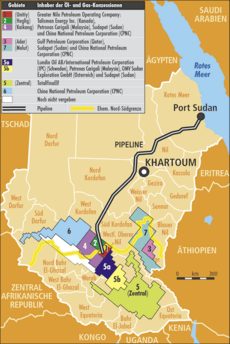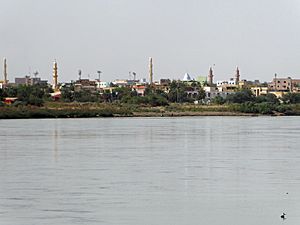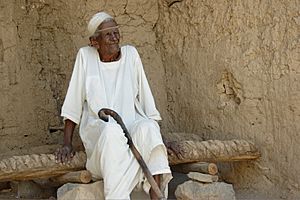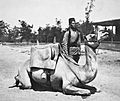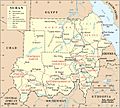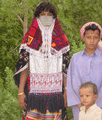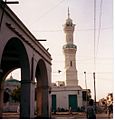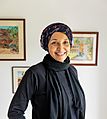Sudan facts for kids
Quick facts for kids
Republic of the Sudan
|
|
|---|---|
|
|
|
|
Motto: النصر لنا
an-Naṣr lanā "Victory is ours" |
|
|
Anthem: نحن جند اللّٰه، جند الوطن
Naḥnu jund Allah, jund al-waṭan "We are Soldiers of God, Soldiers of the Homeland" |
|
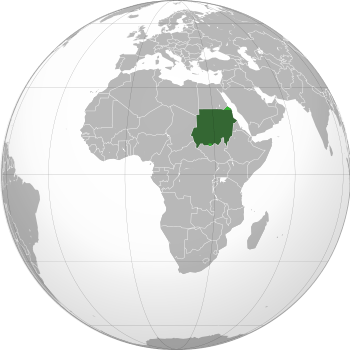
Location of the Republic of the Sudan Territory claimed but not controlled
|
|
| Capital and largest city
|
Khartoum |
| Capital-in-exile | Port Sudan |
| Official languages | |
| Ethnic groups | |
| Religion
(2020)
|
|
| Demonym(s) | Sudanese |
| Government | Federal republic under a military junta |
|
|
|
|
| Legislature | Vacant |
| Formation | |
| 2500 BC | |
| 1070 BC | |
| c. 350 | |
|
• Tunjur, Funj, and Darfur Sultanates
|
c. 1500 |
| 1820 | |
| 1885 | |
| 1899 | |
|
• Independence
|
1 January 1956 |
|
• Democratic Republic of the Sudan
|
25 May 1969 |
|
• Republic of the Sudan (1985–2019)
|
6 April 1985 |
|
• Secession of South Sudan
|
9 July 2011 |
| 19 December 2018 | |
|
• 2019 Draft Constitutional Declaration effective
|
20 August 2019 |
| Area | |
|
• Total
|
1,886,068 km2 (728,215 sq mi) (15th) |
| Population | |
|
• 2024 estimate
|
50,467,278 (30th) |
|
• Density
|
21.3/km2 (55.2/sq mi) (202nd) |
| GDP (PPP) | 2023 estimate |
|
• Total
|
|
|
• Per capita
|
|
| GDP (nominal) | 2023 estimate |
|
• Total
|
|
|
• Per capita
|
|
| Gini (2014) | ▼ 34.2 medium |
| HDI (2022) | low · 170th |
| Currency | Sudanese pound (SDG) |
| Time zone | UTC+2 (CAT) |
| Date format | dd/mm/yyyy |
| Driving side | right |
| Calling code | +249 |
| ISO 3166 code | SD |
| Internet TLD | .sd سودان. |
Sudan is a country in Africa. The official name of Sudan is The Republic of Sudan. Its capital is Khartoum. Sudan has a population of 50 million people as of 2024. It occupies 1,886,068 square kilometres (728,215 square miles), making it Africa's third-largest country by area and the third-largest by area in the Arab League.
Contents
Etymology
The country's name Sudan is a name given historically to the large Sahel region of West Africa to the immediate west of modern-day Sudan. Historically, Sudan referred to both the geographical region, stretching from Senegal on the Atlantic Coast to Northeast Africa and the modern Sudan.
The name derives from the Arabic bilād as-sūdān (بلاد السودان), or "The Land of the Blacks". The name is one of various toponyms sharing similar etymologies, in reference to the very dark skin of the indigenous people. Prior to this, Sudan was known as Nubia and Ta Nehesi or Ta Seti by Ancient Egyptians named for the Nubian and Medjay archers or bowmen.
Since 2011, Sudan is also sometimes referred to as North Sudan to distinguish it from South Sudan.
History
The area that is now Sudan witnessed the Khormusan (c. 40000–16000 BC), Halfan culture (c. 20500–17000 BC), Sebilian (c. 13000–10000 BC), Qadan culture (c. 15000–5000 BC), the war of Jebel Sahaba, the earliest known war in the world, around 11500 BC, A-Group culture (c. 3800–3100 BC), Kingdom of Kerma (c. 2500–1500 BC), the Egyptian New Kingdom (c. 1500–1070 BC), and the Kingdom of Kush (c. 785 BC – 350 AD). After the fall of Kush, the Nubians formed the three Christian kingdoms of Nobatia, Makuria, and Alodia.
Between the 14th and 15th centuries, most of Sudan was gradually settled by Arab nomads. From the 16th to the 19th centuries, central and eastern Sudan were dominated by the Funj sultanate, while Darfur ruled the west and the Ottomans the east. In 1811, Mamluks established a state at Dunqulah as a base for their slave trading. Under Turco-Egyptian rule of Sudan after the 1820s, the practice of trading slaves was entrenched along a north–south axis, with slave raids taking place in southern parts of the country and slaves being transported to Egypt and the Ottoman Empire.
From the 19th century, the entirety of Sudan was conquered by the Egyptians under the Muhammad Ali dynasty. Religious-nationalist fervour erupted in the Mahdist Uprising in which Mahdist forces were eventually defeated by a joint Egyptian-British military force. In 1899, under British pressure, Egypt agreed to share sovereignty over Sudan with the United Kingdom as a condominium. In effect, Sudan was governed as a British possession.
The Egyptian revolution of 1952 toppled the monarchy and demanded the withdrawal of British forces from all of Egypt and Sudan. Muhammad Naguib, one of the two co-leaders of the revolution and Egypt's first President, was half-Sudanese and had been raised in Sudan. He made securing Sudanese independence a priority of the revolutionary government. The following year, under Egyptian and Sudanese pressure, the British agreed to Egypt's demand for both governments to terminate their shared sovereignty over Sudan and to grant Sudan independence. On 1 January 1956, Sudan was duly declared an independent state.
After Sudan became independent, the Gaafar Nimeiry regime began Islamist rule. This exacerbated the rift between the Islamic North, the seat of the government, and the Animists and Christians in the South. Differences in language, religion, and political power erupted in a civil war between government forces, influenced by the National Islamic Front (NIF), and the southern rebels, whose most influential faction was the Sudan People's Liberation Army (SPLA), which eventually led to the independence of South Sudan in 2011. Between 1989 and 2019, a 30-year-long military dictatorship led by Omar al-Bashir ruled Sudan and committed widespread human rights abuses, including persecution of minorities, alleged sponsorship of global terrorism, and ethnic genocide in Darfur from 2003–2020. Overall, the regime killed an estimated 300,000 to 400,000 people. Protests erupted in 2018, demanding Bashir's resignation, which resulted in a coup d'état on 11 April 2019 and Bashir's imprisonment. Sudan is currently embroiled in a civil war between two rival factions, the Sudanese Armed Forces (SAF), and the paramilitary Rapid Support Forces (RSF).
Geography
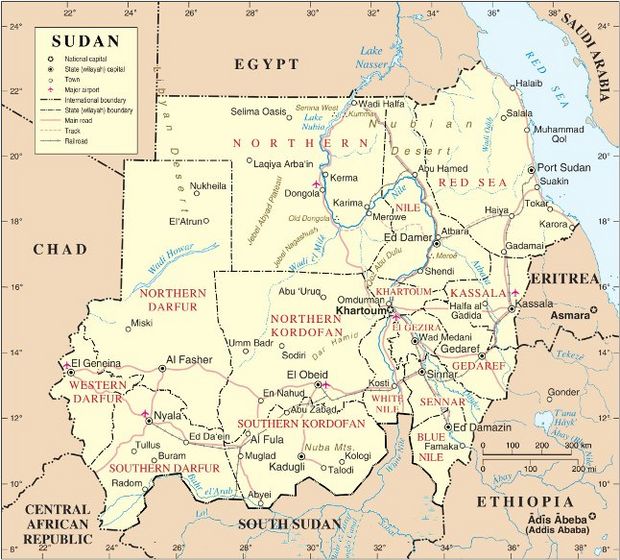
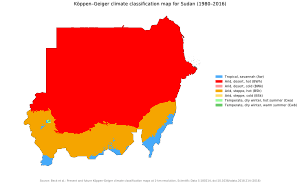
Sudan is situated in northern Africa, with an 853 km (530 mi) coastline bordering the Red Sea. It has land borders with Egypt, Eritrea, Ethiopia, South Sudan, the Central African Republic, Chad, and Libya. With an area of 1,886,068 km2 (728,215 sq mi), it is the third-largest country on the continent (after Algeria and Democratic Republic of the Congo) and the sixteenth-largest in the world.
Sudan lies between latitudes 8° and 23°N. The terrain is generally flat plains, broken by several mountain ranges. In the west, the Deriba Caldera (3,042 m or 9,980 ft), located in the Marrah Mountains, is the highest point in Sudan. In the east are the Red Sea Hills.
The Blue Nile and White Nile rivers meet in Khartoum to form the Nile, which flows northwards through Egypt to the Mediterranean Sea. The Blue Nile's course through Sudan is nearly 800 km (497 mi) long and is joined by the Dinder and Rahad Rivers between Sennar and Khartoum. The White Nile within Sudan has no significant tributaries.
There are several dams on the Blue and White Niles. Among them are the Sennar and Roseires Dams on the Blue Nile, and the Jebel Aulia Dam on the White Nile. There is also Lake Nubia on the Sudanese-Egyptian border.
Rich mineral resources are available in Sudan including asbestos, chromite, cobalt, copper, gold, granite, gypsum, iron, kaolin, lead, manganese, mica, natural gas, nickel, petroleum, silver, tin, uranium and zinc.
Climate
The amount of rainfall increases towards the south. The central and the northern part have extremely dry desert areas such as the Nubian Desert to the northeast and the Bayuda Desert to the east; in the south, there are grasslands and tropical savanna. Sudan's rainy season lasts for about four months (June to September) in the north, and up to six months (May to October) in the south.
The dry regions are plagued by sandstorms, known as haboob, which can completely block out the sun. In the northern and western semi-desert areas, people rely on the scant rainfall for basic agriculture and many are nomadic, travelling with their herds of sheep and camels. Nearer the River Nile, there are well-irrigated farms growing cash crops. The sunshine duration is very high all over the country but especially in deserts where it could soar to over 4,000 h per year.
Administrative divisions
Sudan is divided into 18 states (wilayat, sing. wilayah). They are further divided into 133 districts.
- Gezira
- Al Qadarif
- Blue Nile
- Central Darfur
- East Darfur
- Kassala
- Khartoum
- North Darfur
- North Kordofan
- Northern
- Red Sea
- River Nile
- Sennar
- South Darfur
- South Kordofan
- West Darfur
- West Kordofan
- White Nile
Economy
Oil was Sudan's main export, with production increasing dramatically during the late 2000s, in the years before South Sudan gained independence in July 2011. With rising oil revenues, the Sudanese economy was booming, with a growth rate of about nine percent in 2007. The independence of oil-rich South Sudan, however, placed most major oilfields out of the Sudanese government's direct control and oil production in Sudan fell from around 450,000 barrels per day (72,000 m3/d) to under 60,000 barrels per day (9,500 m3/d). Production has since recovered to hover around 250,000 barrels per day (40,000 m3/d) for 2014–15.
In order to export oil, South Sudan relies on a pipeline to Port Sudan on Sudan's Red Sea coast, as South Sudan is a landlocked country, as well as the oil refining facilities in Sudan. In August 2012, Sudan and South Sudan agreed a deal to transport South Sudanese oil through Sudanese pipelines to Port Sudan.
The People's Republic of China is one of Sudan's major trading partners, China owns a 40 percent share in the Greater Nile Petroleum Operating Company. The country also sells Sudan small arms, which have been used in military operations such as the conflicts in Darfur and South Kordofan.
Agricultural production remains Sudan's most-important sector, employing 80 percent of the workforce and contributing 39 percent of GDP, but most farms remain rain-fed and susceptible to drought. Instability, adverse weather and weak world-agricultural prices ensures that much of the population will remain at or below the poverty line for years.
The Merowe Dam, also known as Merowe Multi-Purpose Hydro Project or Hamdab Dam, is a large construction project in northern Sudan, about 350 kilometres (220 mi) north of the capital, Khartoum. It is situated on the River Nile, close to the Fourth Cataract where the river divides into multiple smaller branches with large islands in between. Merowe is a city about 40 kilometres (25 mi) downstream from the dam's construction site.
The main purpose of the dam will be the generation of electricity. Its dimensions make it the largest contemporary hydropower project in Africa. The construction of the dam was finished December 2008, supplying more than 90 percent of the population with electricity. Other gas-powered generating stations are operational in Khartoum State and other states.
Largest cities
- Omdurman - pop = 1,849,659
- Khartoum - pop = 1,410,858
- Khartoum North - pop = 1,012,211
- Nyala - pop = 492,984
- Port Sudan - pop = 394,561
- El-Obeid - pop = 345,126
- Kassala - pop = 298,529
- Wad Madani - pop = 289,482
- El-Gadarif - pop = 269,395
- Al-Fashir - pop = 217,827
Ethnic groups
The Arab presence is estimated at 70% of the Sudanese population and they are mostly Arabized Nubians. Others include North Sudan Nubians, Zurga(South and West Sudan), and Copts.
Sudan has 597 groups that speak over 400 different languages and dialects. Sudanese Arabs are by far the largest ethnic group in Sudan. They are almost entirely Muslims; while the majority speak Sudanese Arabic, some other Arab tribes speak different Arabic dialects like Awadia and Fadnia tribes and Bani Arak tribes who speak Najdi Arabic; and Beni Ḥassān, Al-Ashraf and Rashaida who speak Hejazi Arabic. In addition, the Western province comprises various ethnic groups, while a few Arab Bedouin of the northern Rizeigat and others who speak Sudanese Arabic share the same culture and backgrounds of the Sudanese Arabs.
The majority of Arabised and indigenous tribes like the Fur, Zaghawa, Borgo, Masalit and some Baggara ethnic groups, who speak Chadian Arabic, show less cultural integration because of cultural, linguistic and genealogical variations with other Arab and Arabised tribes.
Sudanese Arabs of Northern and Eastern parts descend primarily from migrants from the Arabian Peninsula and intermarriages with the pre-existing indigenous populations of Sudan, especially the Nubian people, who also share a common history with Egypt. Additionally, a few pre-Islamic Arabian tribes existed in Sudan from earlier migrations into the region from Western Arabia, although most Arabs in Sudan are dated from migrations after the 12th century.
The vast majority of Arab tribes in Sudan migrated into the Sudan in the 12th century, intermarried with the indigenous Nubian and other African populations and introduced Islam.
Sudan consists of numerous other non-Arabic groups, such as the Masalit, Zaghawa, Fulani, Northern Nubians, Nuba, and the Beja people.
There is also a small, but prominent Greek community.
Languages
Approximately 70 languages are native to Sudan. Sudan has multiple regional sign languages, which are not mutually intelligible. A 2009 proposal for a unified Sudanese Sign Language had been worked out.
Prior to 2005, Arabic was the nation's sole official language. In the 2005 constitution, Sudan's official languages became Arabic and English. The literacy rate is 70.2% of the total population (male: 79.6%, female: 60.8%).
Religion
At the 2011 division which split off South Sudan, over 97% of the population in the remaining Sudan adhered to Islam. Most Muslims are divided between two groups: Sufi and Salafi Muslims.
Culture
Sudanese culture melds the behaviours, practices, and beliefs of about 578 ethnic groups, communicating in numerous different dialects and languages, in a region microcosmic of Africa, with geographic extremes varying from sandy desert to tropical forest. Recent evidence suggests that while most citizens of the country identify strongly with both Sudan and their religion, Arab and African supranational identities are much more polarising and contested.
Clothing
Most Sudanese wear either traditional or western attire. A traditional garb widely worn by Sudanese men is the jalabiya, which is a loose-fitting, long-sleeved, collarless ankle-length garment also common to Egypt. The jalabiya is often accompanied by a large turban and a scarf, and the garment may be white, coloured, striped, and made of fabric varying in thickness, depending on the season of the year and personal preferences.
The most common dress for Sudanese women is the thobe or thawb, pronounced tobe in Sudanese dialect. The thobe is a white or colourful long, one-piece cloth that women wrap around their inner garments, usually covering their head and hair.
Due to a 1991 penal code (Public Order Law), women were not allowed to wear trousers in public. The punishment for wearing trousers could be up to 40 lashes,.
Sport
Like in many countries, football is the most popular sport also in Sudan. The Sudan Football Association was founded in 1936 and thus it became one of the oldest football associations to exist in Africa. However, before the foundation of the Football Association, Sudan had started experiencing football brought to the country by the British colonizers since early 20th century via Egypt. Other Sudanese clubs founded at that time include Al-Hilal Omdurman, Al-Merrikh, which led to popularization of football in the country. The Khartoum League became the first national league to be played in Sudan, laying ground for the future development of Sudanese football.
Since September 2019, there has been an official national league for women's football clubs that started on the basis of informal women's clubs since the beginning of the 2000s. In 2021, the Sudan women's national football team participated for the first time in the Arab Women's Cup, held in Cairo, Egypt.
Sudan's national beach volleyball team competed at the 2018–2020 CAVB Beach Volleyball Continental Cup in both the women's and the men's section. In June 2022, Patricia Seif El Din El Haj, the first Sudanese woman wrestler to participate in an African championship, was photographed by Reuters photographer Mohamed Nureldin Abdallah, as she got ready to travel to Nigeria to prepare for the 2024 Summer Olympic games.
Related pages
- List of rivers of Sudan
- Sudan at the Olympics
- Sudan national football team
- Muhammed Ahmed, the Mahdi
Images for kids
-
Nubian pyramids in Meroë.
-
Muhammad Ahmad ruler of Sudan, 1881–1885.
-
The Flight of the Khalifa after his Defeat at the Battle of Omdurman.
-
The Mahdist War was fought between a group of Muslim dervishes, called Mahdists, who had over-run much of Sudan, and the British forces.
-
A map of Sudan. The Hala'ib Triangle has been under Egyptian administration since 2000.
-
JEM rebels in Darfur. Both the government and the rebels have been accused of atrocities.
-
Darfur refugee camp in Chad, 2005
-
Student from Khartoum
-
The Arabic-speaking Rashaida came to Sudan from Arabia about 170 years ago.
-
Minaret in Port Sudan
-
Sudanese tourists by the Meroë pyramids in various types of clothing.
See also
 In Spanish: Sudán para niños
In Spanish: Sudán para niños





